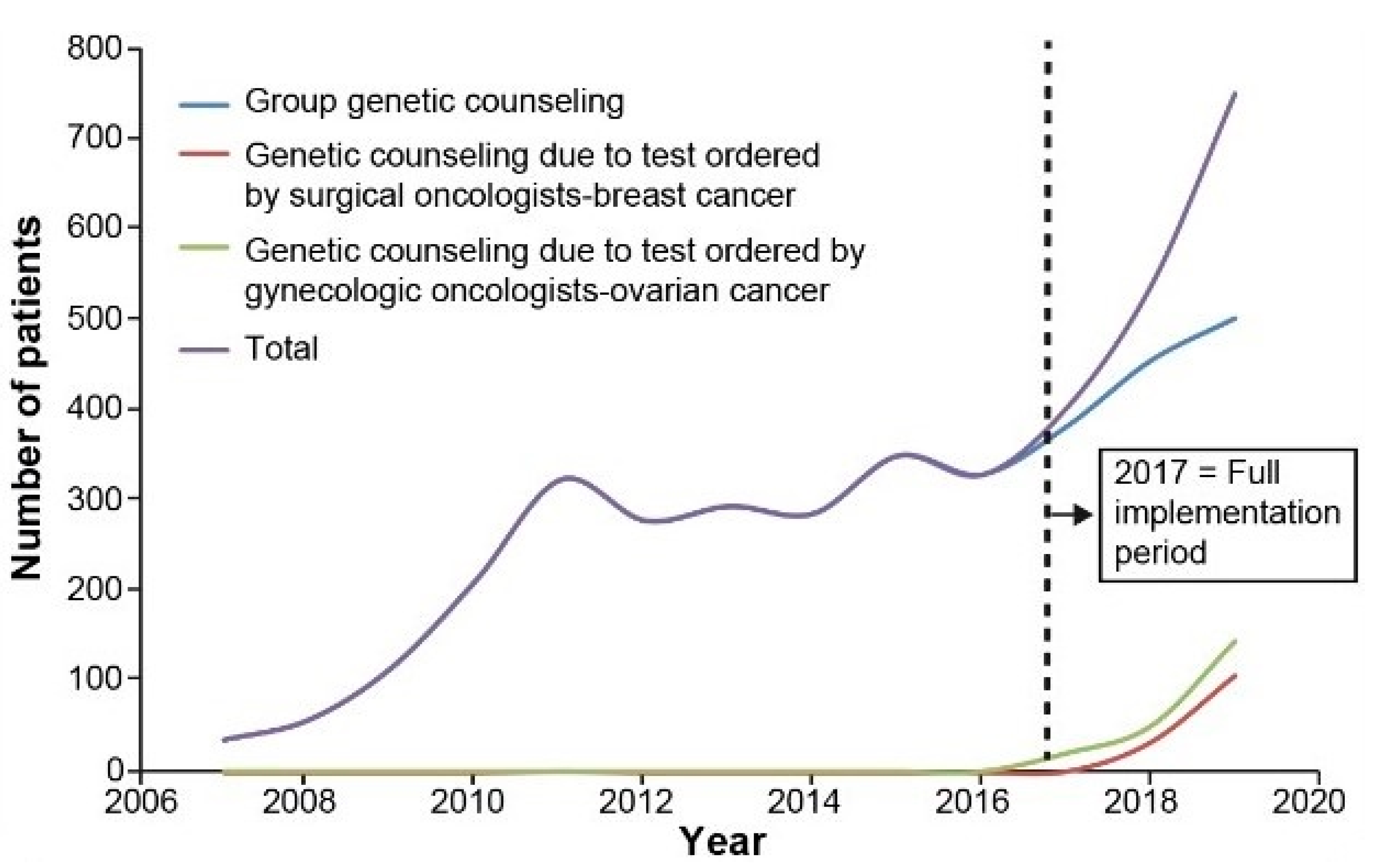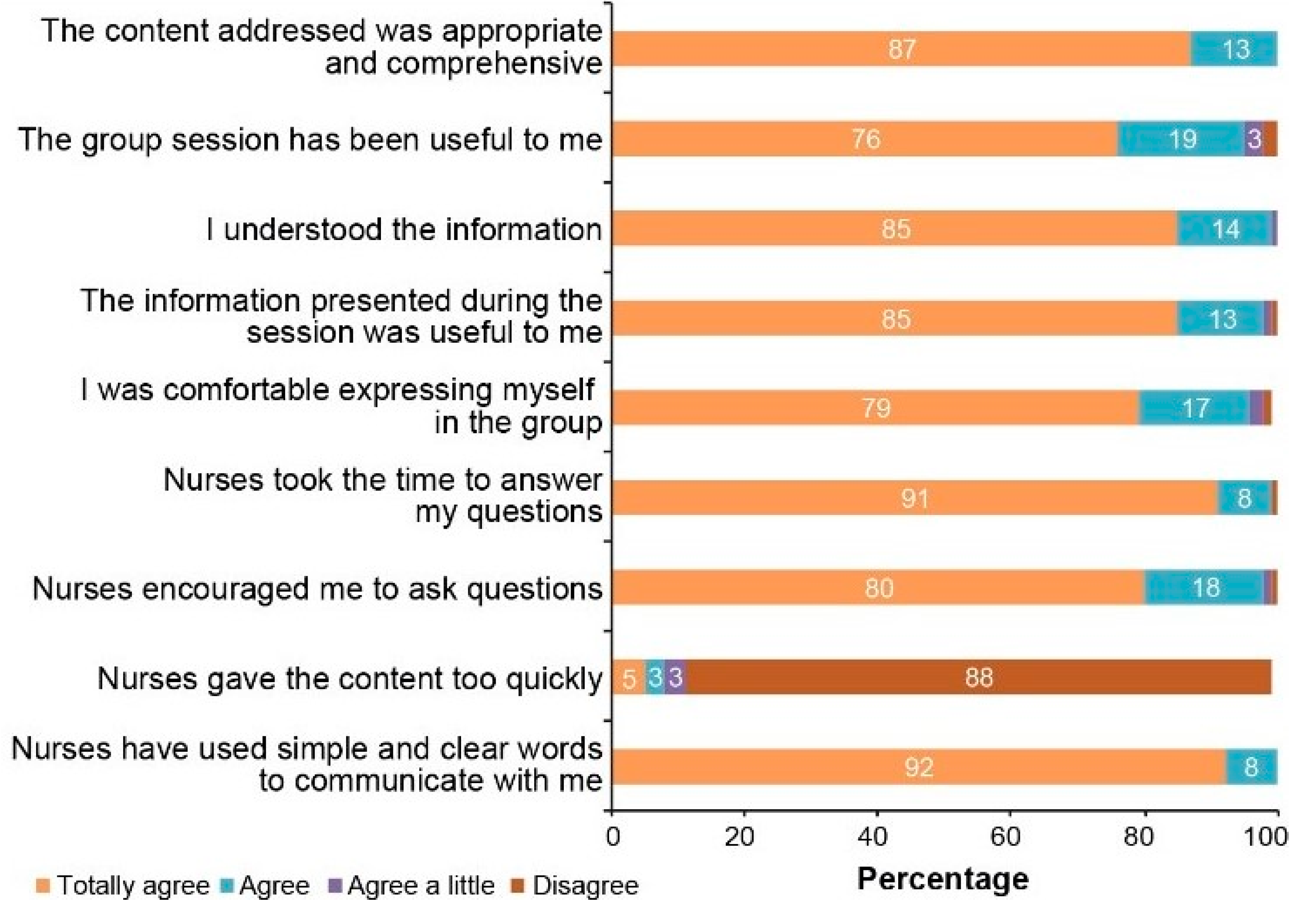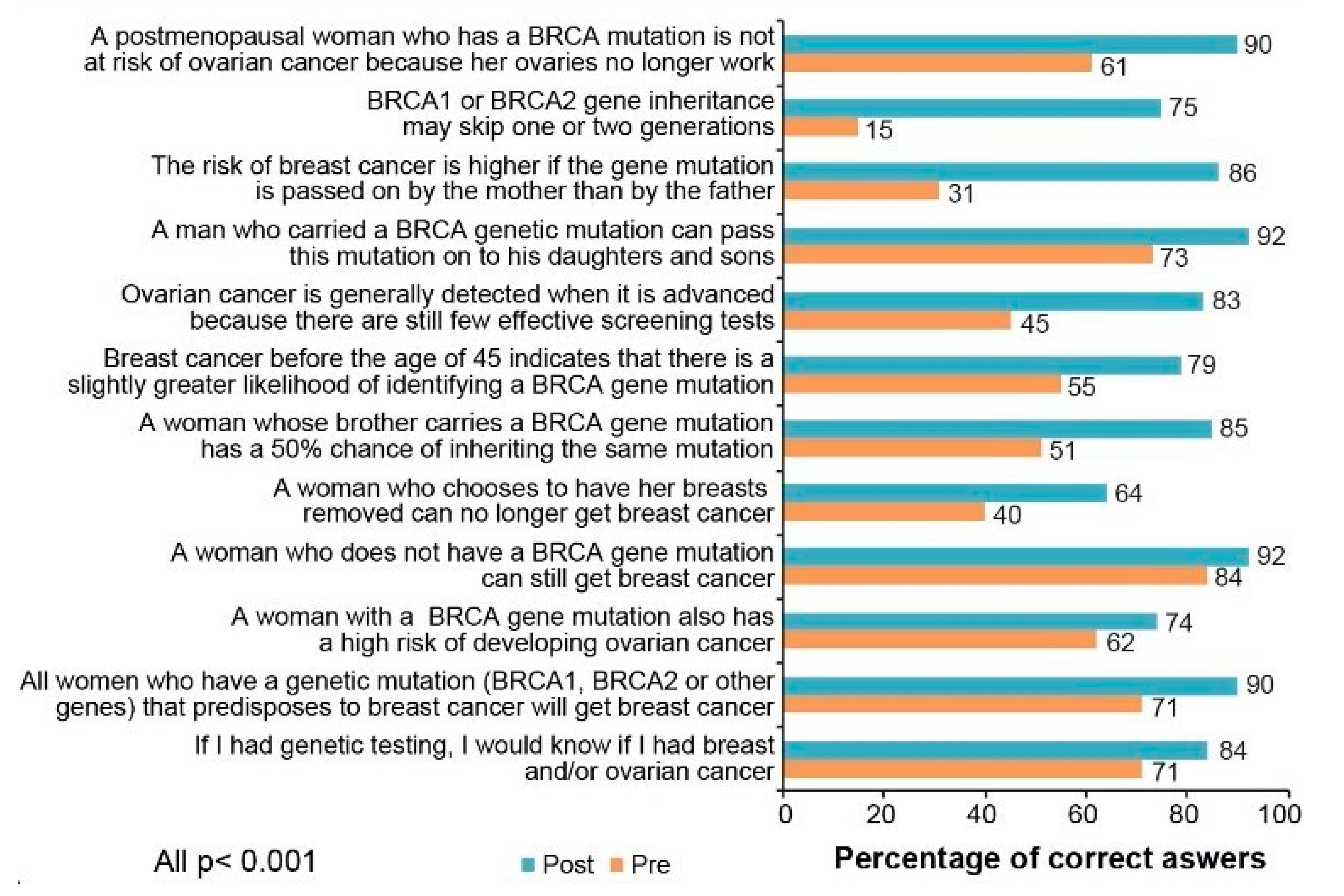A Collaborative Model to Implement Flexible, Accessible and Efficient Oncogenetic Services for Hereditary Breast and Ovarian Cancer: The C-MOnGene Study
Abstract
Simple Summary
Abstract
1. Introduction
2. Research Methods and Analyses
2.1. Study Design
2.2. Cases Selection
2.3. Data Collection and Procedures
2.4. Data Management and Analysis
3. Discussion
4. Ethics and Discussion
Author Contributions
Funding
Institutional Review Board Statement
Informed Consent Statement
Data Availability Statement
Acknowledgments
Conflicts of Interest
References
- Nagy, R.; Sweet, K.; Eng, C. Highly penetrant hereditary cancer syndromes. Oncogene 2004, 23, 6445–6470. [Google Scholar] [CrossRef]
- Fitzmaurice, C.; Allen, C.; Barber, R.M.; Barregard, L.; Bhutta, Z.A.; Brenner, H.; Dicker, D.J.; Chimed-Orchir, O.; Dandona, R.; Dandona, L. Global, regional, and national cancer incidence, mortality, years of life lost, years lived with disability, and disability-adjusted life-years for 32 cancer groups, 1990 to 2015: A systematic analysis for the global burden of disease study. JAMA Oncol. 2017, 3, 524–548. [Google Scholar]
- van der Groep, P.; van der Wall, E.; van Diest, P.J. Pathology of hereditary breast cancer. Cell. Oncol. 2011, 34, 71–88. [Google Scholar] [CrossRef]
- Castro, E.; Goh, C.; Olmos, D.; Saunders, E.; Leongamornlert, D.; Tymrakiewicz, M.; Mahmud, N.; Dadaev, T.; Govindasami, K.; Guy, M.; et al. Germline BRCA Mutations Are Associated with Higher Risk of Nodal Involvement, Distant Metastasis, and Poor Survival Outcomes in Prostate Cancer. J. Clin. Oncol. 2013, 31, 1748–1757. [Google Scholar] [CrossRef] [PubMed]
- Garber, J.E.; Offit, K. Hereditary Cancer Predisposition Syndromes. J. Clin. Oncol. 2005, 23, 276–292. [Google Scholar] [CrossRef]
- Foulkes, W.D. Inherited Susceptibility to Common Cancers. N. Engl. J. Med. 2008, 359, 2143–2153. [Google Scholar] [CrossRef]
- Antoniou, A.; Pharoah, P.; Narod, S.; Risch, H.; Eyfjord, J.; Hopper, J.; Loman, N.; Olsson, H.; Johannsson, O.; Borg, Å.; et al. Average Risks of Breast and Ovarian Cancer Associated with BRCA1 or BRCA2 Mutations Detected in Case Series Unselected for Family History: A Combined Analysis of 22 Studies. Am. J. Hum. Genet. 2003, 72, 1117–1130. [Google Scholar] [CrossRef]
- Chen, S.; Parmigiani, G. Meta-Analysis ofBRCA1andBRCA2Penetrance. J. Clin. Oncol. 2007, 25, 1329–1333. [Google Scholar] [CrossRef] [PubMed]
- Kuchenbaecker, K.B.; Hopper, J.L.; Barnes, D.R.; Phillips, K.; Mooij, T.M.; Jervis, S.; Van Leeuwen, F.E.; Milne, R.L.; Andrieu, N.; Goldgar, D.E.; et al. Risks of Breast, Ovarian, and Contralateral Breast Cancer for BRCA1 and BRCA2 Mutation Carriers. JAMA 2017, 317, 2402–2416. [Google Scholar] [CrossRef] [PubMed]
- Molina-Montes, E.; Pérez-Nevot, B.; Pollán, M.; Sánchez-Cantalejo, E.; Espín, J.; Sánchez, M.-J. Cumulative risk of second primary contralateral breast cancer in BRCA1/BRCA2 mutation carriers with a first breast cancer: A systematic review and meta-analysis. Breast 2014, 23, 721–742. [Google Scholar] [CrossRef] [PubMed]
- Tung, N.M.; Garber, J.E. BRCA 1/2 testing: Therapeutic implications for breast cancer management. Br. J. Cancer 2018, 119, 141. [Google Scholar] [CrossRef]
- Balmaña, J.; Díez, O.; Rubio, I.T.; Cardoso, F. BRCA in breast cancer: ESMO Clinical Practice Guidelines. Ann. Oncol. 2011, 22, vi31–vi34. [Google Scholar] [CrossRef]
- Moyer, V.A. Risk Assessment, Genetic Counseling, and Genetic Testing for BRCA-Related Cancer in Women: U.S. Preventive Services Task Force Recommendation Statement. Ann. Intern. Med. 2014, 160, 271–281. [Google Scholar] [CrossRef] [PubMed]
- Hanley, G.E.; McAlpine, J.N.; Cheifetz, R.; Schrader, K.A.; McCullum, M.; Huntsman, D. Selected Medical Interventions in Women with a Deleterious Brca Mutation: A Population-Based Study in British Columbia. Curr. Oncol. 2019, 26, 17–23. [Google Scholar] [CrossRef] [PubMed]
- Meijers-Heijboer, H.; Van Geel, B.; Van Putten, W.L.; Henzen-Logmans, S.C.; Seynaeve, C.; Menke-Pluymers, M.B.; Bartels, C.C.; Verhoog, L.C.; Ouweland, A.M.V.D.; Niermeijer, M.F.; et al. Breast Cancer after Prophylactic Bilateral Mastectomy in Women with aBRCA1orBRCA2Mutation. N. Engl. J. Med. 2001, 345, 159–164. [Google Scholar] [CrossRef] [PubMed]
- Heemskerk-Gerritsen, B.; Brekelmans, C.; Menke-Pluymers, M.; van Geel, A.; Tilanus-Linthorst, M.; Bartels, C.; Tan, M.; Meijers-Heijboer, H.; Klijn, J.; Seynaeve, C. Prophylactic Mastectomy in BRCA1/2 Mutation Carriers and Women at Risk of Hereditary Breast Cancer: Long-Term Experiences at the Rotterdam Family Cancer Clinic. Ann. Surg. Oncol. 2007, 14, 3335–3344. [Google Scholar] [CrossRef]
- Kauff, N.; Satagopan, J.M.; Robson, M.E.; Scheuer, L.; Hensley, M.; Hudis, C.A.; Ellis, N.A.; Boyd, J.; Borgen, P.I.; Barakat, R.R.; et al. Risk-Reducing Salpingo-oophorectomy in Women with aBRCA1orBRCA2Mutation. N. Engl. J. Med. 2002, 346, 1609–1615. [Google Scholar] [CrossRef] [PubMed]
- Domchek, S.M.; Gaudet, M.M.; Stopfer, J.E.; Fleischaut, M.H.; Powers, J.; Kauff, N.; Offit, K.; Nathanson, K.L.; Robson, M. Breast cancer risks in individuals testing negative for a known family mutation in BRCA1 or BRCA2. Breast Cancer Res. Treat. 2009, 119, 409–414. [Google Scholar] [CrossRef]
- Rebbeck, T.R.; Kauff, N.; Domchek, S.M. Meta-analysis of Risk Reduction Estimates Associated with Risk-Reducing Salpingo-oophorectomy in BRCA1 or BRCA2 Mutation Carriers. J. Natl. Cancer Inst. 2009, 101, 80–87. [Google Scholar] [CrossRef]
- Moorman, P.G.; Havrilesky, L.J.; Gierisch, J.M.; Coeytaux, R.R.; Lowery, W.J.; Urrutia, R.P.; Dinan, M.; McBroom, A.J.; Hasselblad, V.; Sanders, G.D.; et al. Oral Contraceptives and Risk of Ovarian Cancer and Breast Cancer Among High-Risk Women: A Systematic Review and Meta-Analysis. J. Clin. Oncol. 2013, 31, 4188–4198. [Google Scholar] [CrossRef] [PubMed]
- King, M.; Wieand, S.; Hale, K.; Lee, M.; Walsh, T.; Owens, K.; Tait, J.; Ford, L.; Dunn, B.; Costantino, J. National surgical adjuvant breast and bowel project. Tamoxifen and breast cancer incidence among women with inherited mutations in BRCA1 and BRCA2: National Surgical Adjuvant Breast and Bowel Project (NSABP-P1) Breast Cancer Prevention Trial. JAMA 2001, 286, 2251–2256. [Google Scholar] [CrossRef] [PubMed]
- Plevritis, S.K.; Kurian, A.W.; Sigal, B.M.; Daniel, B.L.; Ikeda, D.M.; Stockdale, F.E.; Garber, A.M. Cost-effectiveness of Screening BRCA1/2 Mutation Carriers with Breast Magnetic Resonance Imaging. JAMA 2006, 295, 2374–2384. [Google Scholar] [CrossRef] [PubMed]
- Owens, D.K.; Davidson, K.W.; Krist, A.H.; Barry, M.J.; Cabana, M.; Caughey, A.B.; Doubeni, C.A.; Epling, J.W.; Kubik, M.; Landefeld, C.S. Risk assessment, genetic counseling, and genetic testing for BRCA-related cancer: US Preventive Services Task Force recommendation statement. JAMA 2019, 322, 652–665. [Google Scholar]
- Institut National D’excellence en Santé et en Services Sociaux (INESSS). Recherche de Mutations dans les Gènes BRCA1 ET BRCA2 par Séquençage de Nouvelle Génération. Available online: https://www.inesss.qc.ca/fileadmin/doc/INESSS/Analyse_biomedicale/Juin_2016/INESSS-Avis_analyses_bm-juin16_9_Recherche_mutations_genes_BRCA1_BRCA2_sequencage_nouvelle_generation.pdf (accessed on 13 October 2020).
- Nabi, H.; Dorval, M.; Chiquette, J.; Simard, J. Increased Use of BRCA Mutation Test in Unaffected Women Over the Period 2004–2014 in the U.S.: Further Evidence of the “Angelina Jolie Effect”? Am. J. Prev. Med. 2017, 53, e195–e196. [Google Scholar] [CrossRef] [PubMed]
- Trepanier, A.M.; Allain, D.C. Models of Service Delivery for Cancer Genetic Risk Assessment and Counseling. J. Genet. Couns. 2013, 23, 239–253. [Google Scholar] [CrossRef] [PubMed]
- Canadian Association of Genetic Counsellors. Membership Directory. Available online: https://cichprofile.ca/module/2/section/3/page/access-to-services-genetic-counsellors/ (accessed on 13 October 2020).
- Quebec Association of Genetic Counsellors. How to Become a Genetic Counsellor. Available online: http://accgq-qagc.ca/become-a-genetic-counsellor/ (accessed on 25 February 2020).
- Association des Médecins Généticiens du Québec. Speciality Profile. Available online: https://www.fmsq.org/en/la-fmsq/organisation/associations/association-des-medecins-geneticiens-du-quebec (accessed on 25 February 2020).
- Theobald, K.A.; Susswein, L.R.; Marshall, M.L.; Roberts, M.E.; Mester, J.L.; Speyer, D.; Williams, R.N.W.; Knapke, S.C.; Solomon, S.R.; Murphy, P.D.; et al. Utility of Expedited Hereditary Cancer Testing in the Surgical Management of Patients with a New Breast Cancer Diagnosis. Ann. Surg. Oncol. 2018, 25, 3556–3562. [Google Scholar] [CrossRef]
- Chiquette, J. Portrait Oncogénétique au Québec. Available online: https://www.agora-inscription.ca/documents/512/files/symposium2017-portrait%20oncoge%CC%81ne%CC%81tique.pdf (accessed on 24 September 2020).
- Cancer Care Ontario. Recommandation Report for Ontario’s Clinical Genetic Services. Available online: https://www.cancercareontario.ca/en/node/56256 (accessed on 28 May 2021).
- Hoskovec, J.M.; Bennett, R.L.; Carey, M.E.; DaVanzo, J.E.; Dougherty, M.; Hahn, S.E.; Leroy, B.S.; O’Neal, S.; Richardson, J.G.; Wicklund, C.A. Projecting the Supply and Demand for Certified Genetic Counselors: A Workforce Study. J. Genet. Couns. 2018, 27, 16–20. [Google Scholar] [CrossRef]
- Hoskins, P.J.; Gotlieb, W.H. Missed therapeutic and prevention opportunities in women with BRCA-mutated epithelial ovarian cancer and their families due to low referral rates for genetic counseling and BRCA testing: A review of the literature. CA Cancer J. Clin. 2017, 67, 493–506. [Google Scholar] [CrossRef]
- McCuaig, J.M.; Armel, S.R.; Care, M.; Volenik, A.; Kim, R.H.; Metcalfe, K.A. Next-Generation Service Delivery: A Scoping Review of Patient Outcomes Associated with Alternative Models of Genetic Counseling and Genetic Testing for Hereditary Cancer. Cancers 2018, 10, 435. [Google Scholar] [CrossRef]
- McCuaig, J.M.; Stockley, T.L.; Shaw, P.; Fung-Kee-Fung, M.; Altman, A.D.; Bentley, J.; Bernardini, M.Q.; Cormier, B.; Hirte, H.; Kieser, K.; et al. Evolution of genetic assessment for BRCA-associated gynaecologic malignancies: A Canadian multisociety roadmap. J. Med. Genet. 2018, 55, 571–577. [Google Scholar] [CrossRef]
- Samimi, G.; Bernardini, M.Q.; Brody, L.C.; Caga-Anan, C.F.; Campbell, I.; Chenevix-Trench, G.; Couch, F.J.; Dean, M.; De Hullu, J.A.; Domchek, S.M.; et al. Traceback: A Proposed Framework to Increase Identification and Genetic Counseling of BRCA1 and BRCA2 Mutation Carriers Through Family-Based Outreach. J. Clin. Oncol. 2017, 35, 2329–2337. [Google Scholar] [CrossRef]
- Hallowell, N.; Wright, S.; Stirling, D.; Gourley, C.; Young, O.; Porteous, M. Moving into the mainstream: Healthcare professionals’ views of implementing treatment focussed genetic testing in breast cancer care. Fam. Cancer 2019, 18, 293–301. [Google Scholar] [CrossRef]
- Kemp, Z.; Turnbull, A.; Yost, S.; Seal, S.; Mahamdallie, S.; Poyastro-Pearson, E.; Warren-Perry, M.; Eccleston, A.; Tan, M.-M.; Teo, S.H.; et al. Evaluation of Cancer-Based Criteria for Use in MainstreamBRCA1andBRCA2Genetic Testing in Patients with Breast Cancer. JAMA Netw. Open 2019, 2, e194428. [Google Scholar] [CrossRef]
- Johnson, K.E.; Stake, R.E. The Art of Case Study Research. Mod. Lang. J. 1996, 80, 556. [Google Scholar] [CrossRef]
- Rogers, E.M. Diffusion of Innovations; Simon and Schuster: New York, NY, USA, 2010. [Google Scholar]
- Greenhalgh, T.; Robert, G.; Macfarlane, F.; Bate, P.; Kyriakidou, O. Diffusion of Innovations in Service Organizations: Systematic Review and Recommendations. Milbank Q. 2004, 82, 581–629. [Google Scholar] [CrossRef]
- Lehoux, P.; Blume, S. Technology assessment and the sociopolitics of health technologies. J. Heal. Politi Policy Law 2000, 25, 1083–1120. [Google Scholar] [CrossRef]
- Brehaut, J.C.; O’Connor, A.M.; Wood, T.; Hack, T.F.; Siminoff, L.; Gordon, E.; Feldman-Stewart, D. Validation of a Decision Regret Scale. Med Decis. Mak. 2003, 23, 281–292. [Google Scholar] [CrossRef]
- Nilsson, M.P.; Nilsson, E.D.; Borg, Å.; Brandberg, Y.; Silfverberg, B.; Loman, N. High patient satisfaction with a simplified BRCA1/2 testing procedure: Long-term results of a prospective study. Breast Cancer Res. Treat. 2019, 173, 313–318. [Google Scholar] [CrossRef]
- Munn, Z.; Peters, M.D.J.; Stern, C.; Tufanaru, C.; McArthur, A.; Aromataris, E. Systematic review or scoping review? Guidance for authors when choosing between a systematic or scoping review approach. BMC Med Res. Methodol. 2018, 18, 1–7. [Google Scholar] [CrossRef]
- Canadian Journal of Health Technologies. Guidance Document for the Costing of Health Care Resources in the Canadian Setting: Second Edition. Available online: https://www.cadth.ca/guidance-document-costing-process-2e (accessed on 15 April 2021).
- University, M. McMaster Health Forum: Evidence, Insight, Action. Available online: https://www.mcmasterforum.org/ (accessed on 21 September 2020).
- Braun, V.; Clarke, V. Using thematic analysis in psychology. Qual. Res. Psychol. 2006, 3, 77–101. [Google Scholar] [CrossRef]
- Drummond, M.; Sculpher, M.; Claxton, K.; Stoddart, G.; Torrance, G. Methods for the Economic Evaluation of Health Care Programmes, 4th ed.; Oxford University Press: Oxford, UK, 2015. [Google Scholar]
- Hoomans, T.; Severens, J.L. Economic evaluation of implementation strategies in health care. Implement. Sci. 2014, 9, 1–6. [Google Scholar] [CrossRef]
- Mauskopf, J.A.; Paul, J.E.; Grant, D.M.; Stergachis, A. The Role of Cost-Consequence Analysis in Healthcare Decision-Making. Pharmacoeconomics 1998, 13, 277–288. [Google Scholar] [CrossRef] [PubMed]
- Daly, M.B.; Pilarski, R.; Yurgelun, M.B.; Berry, M.P.; Buys, S.S.; Dickson, P.; Domchek, S.M.; Elkhanany, A.; Friedman, S.; Garber, J.E.; et al. NCCN Guidelines Insights: Genetic/Familial High-Risk Assessment: Breast, Ovarian, and Pancreatic, Version 1.2020. J. Natl. Compr. Cancer Netw. 2020, 18, 380–391. [Google Scholar] [CrossRef] [PubMed]
- Kamps, R.; Brandão, R.D.; Bosch, B.J.V.D.; Paulussen, A.D.C.; Xanthoulea, S.; Blok, M.J.; Romano, A. Next-Generation Sequencing in Oncology: Genetic Diagnosis, Risk Prediction and Cancer Classification. Int. J. Mol. Sci. 2017, 18, 308. [Google Scholar] [CrossRef] [PubMed]
- Scheinberg, T.; Young, A.; Woo, H.; Goodwin, A.; Mahon, K.L.; Horvath, L.G. Mainstream consent programs for genetic counseling in cancer patients: A systematic review. Asia Pacific J. Clin. Oncol. 2020. [Google Scholar] [CrossRef]
- Gouvernement du Québec. 2017 Stratégie Québécoise des Sciences de la vie 2017–2027. Available online: https://cdn-contenu.quebec.ca/cdn-contenu/adm/min/economie/publications-adm/politique/PO_strategie_sciences_vie_2017-2027_MEI.pdf?1569264678 (accessed on 13 October 2020).
- Pilarski, R. The Role of BRCA Testing in Hereditary Pancreatic and Prostate Cancer Families. Am. Soc. Clin. Oncol. Educ. Book 2019, 39, 79–86. [Google Scholar] [CrossRef] [PubMed]
- Pain, E. Genetic counseling: A growing area of opportunity. Science 2016. [Google Scholar] [CrossRef]
- Phillips, K.A.; Deverka, P.A.; Hooker, G.W.; Douglas, M.P. Genetic Test Availability And Spending: Where Are We Now? Where Are We Going? Health Aff. 2018, 37, 710–716. [Google Scholar] [CrossRef]





Publisher’s Note: MDPI stays neutral with regard to jurisdictional claims in published maps and institutional affiliations. |
© 2021 by the authors. Licensee MDPI, Basel, Switzerland. This article is an open access article distributed under the terms and conditions of the Creative Commons Attribution (CC BY) license (https://creativecommons.org/licenses/by/4.0/).
Share and Cite
Lapointe, J.; Dorval, M.; Chiquette, J.; Joly, Y.; Guertin, J.R.; Laberge, M.; Gekas, J.; Hébert, J.; Pomey, M.-P.; Cruz-Marino, T.; et al. A Collaborative Model to Implement Flexible, Accessible and Efficient Oncogenetic Services for Hereditary Breast and Ovarian Cancer: The C-MOnGene Study. Cancers 2021, 13, 2729. https://doi.org/10.3390/cancers13112729
Lapointe J, Dorval M, Chiquette J, Joly Y, Guertin JR, Laberge M, Gekas J, Hébert J, Pomey M-P, Cruz-Marino T, et al. A Collaborative Model to Implement Flexible, Accessible and Efficient Oncogenetic Services for Hereditary Breast and Ovarian Cancer: The C-MOnGene Study. Cancers. 2021; 13(11):2729. https://doi.org/10.3390/cancers13112729
Chicago/Turabian StyleLapointe, Julie, Michel Dorval, Jocelyne Chiquette, Yann Joly, Jason Robert Guertin, Maude Laberge, Jean Gekas, Johanne Hébert, Marie-Pascale Pomey, Tania Cruz-Marino, and et al. 2021. "A Collaborative Model to Implement Flexible, Accessible and Efficient Oncogenetic Services for Hereditary Breast and Ovarian Cancer: The C-MOnGene Study" Cancers 13, no. 11: 2729. https://doi.org/10.3390/cancers13112729
APA StyleLapointe, J., Dorval, M., Chiquette, J., Joly, Y., Guertin, J. R., Laberge, M., Gekas, J., Hébert, J., Pomey, M.-P., Cruz-Marino, T., Touhami, O., Blanchet Saint-Pierre, A., Gagnon, S., Bouchard, K., Rhéaume, J., Boisvert, K., Brousseau, C., Castonguay, L., Fortier, S., ... Nabi, H. (2021). A Collaborative Model to Implement Flexible, Accessible and Efficient Oncogenetic Services for Hereditary Breast and Ovarian Cancer: The C-MOnGene Study. Cancers, 13(11), 2729. https://doi.org/10.3390/cancers13112729







